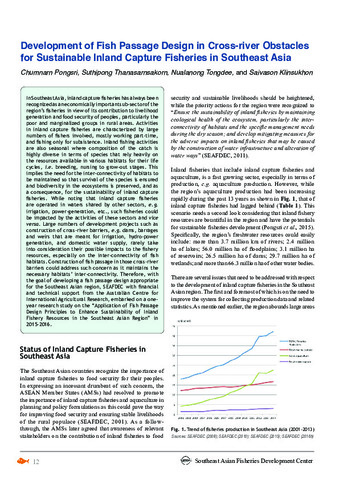Perlihatkan publikasi sederhana
Development of fish passage design in cross-river obstacles for sustainable inland capture fisheries in Southeast Asia
Share
| dc.contributor.author | Pongsri, Chumnarn | |
| dc.contributor.author | Thanasarnsakorn, Suthipong | |
| dc.contributor.author | Tongdee, Nualanong | |
| dc.contributor.author | Klinsukhon, Saivason | |
| dc.date.accessioned | 2017-11-20T08:15:49Z | |
| dc.date.available | 2017-11-20T08:15:49Z | |
| dc.date.issued | 2016 | |
| dc.identifier.issn | 1685-6546 | |
| dc.identifier.uri | http://hdl.handle.net/20.500.12066/999 | |
| dc.description.abstract | In Southeast Asia, inland capture fisheries has always been recognized as an economically important sub-sector of the region’s fisheries in view of its contribution to livelihood generation and food security of peoples, particularly the poor and marginalized groups in rural areas. Activities in inland capture fisheries are characterized by large numbers of fishers involved, mostly working part-time, and fishing only for subsistence. Inland fishing activities are also seasonal where composition of the catch is highly diverse in terms of species that rely heavily on the resources available in various habitats for their life cycles, i.e. breeding, nursing to grow-out stages. This implies the need for the inter-connectivity of habitats to be maintained so that survival of the species is ensured and biodiversity in the ecosystems is preserved, and as a consequence, for the sustainability of inland capture fisheries. While noting that inland capture fisheries are operated in waters shared by other sectors, e.g. irrigation, power-generation, etc., such fisheries could be impacted by the activities of these sectors and vice versa. Large numbers of development projects such as construction of cross-river barriers, e.g. dams, barrages and weirs that are meant for irrigation, hydro-power generation, and domestic water supply, rarely take into consideration their possible impacts to the fishery resources, especially on the inter-connectivity of fish habitats. Construction of fish passage in those cross-river barriers could address such concern as it maintains the necessary habitats’ inter-connectivity. Therefore, with the goal of developing a fish passage design appropriate for the Southeast Asian region, SEAFDEC with financial and technical support from the Australian Centre for International Agricultural Research, embarked on a oneyear research study on the “Application of Fish Passage Design Principles to Enhance Sustainability of Inland Fishery Resources in the Southeast Asian Region” in 2015-2016. | en |
| dc.language.iso | en | en |
| dc.publisher | Secretariat, Southeast Asian Fisheries Development Center | en |
| dc.title | Development of fish passage design in cross-river obstacles for sustainable inland capture fisheries in Southeast Asia | en |
| dc.type | magazineArticle | en |
| dc.citation.volume | 14 | |
| dc.citation.issue | 3 | |
| dc.citation.spage | 12 | |
| dc.citation.epage | 18 | |
| dc.citation.journalTitle | Fish for the People | en |

